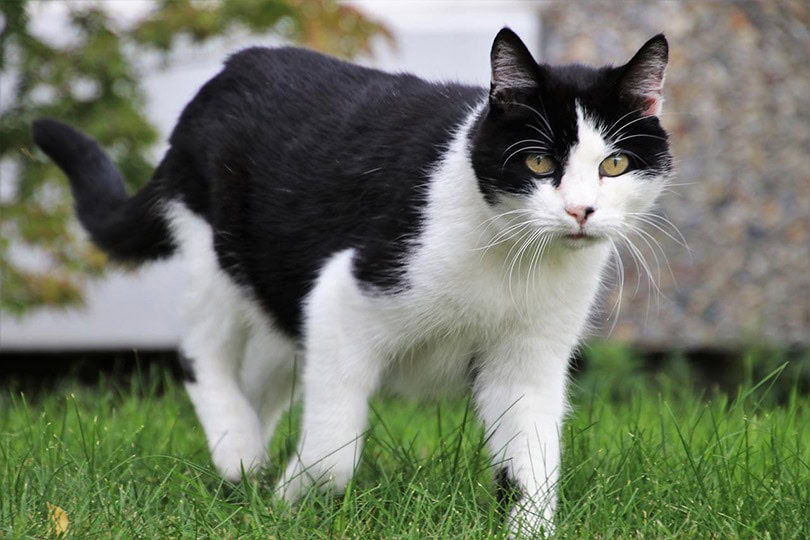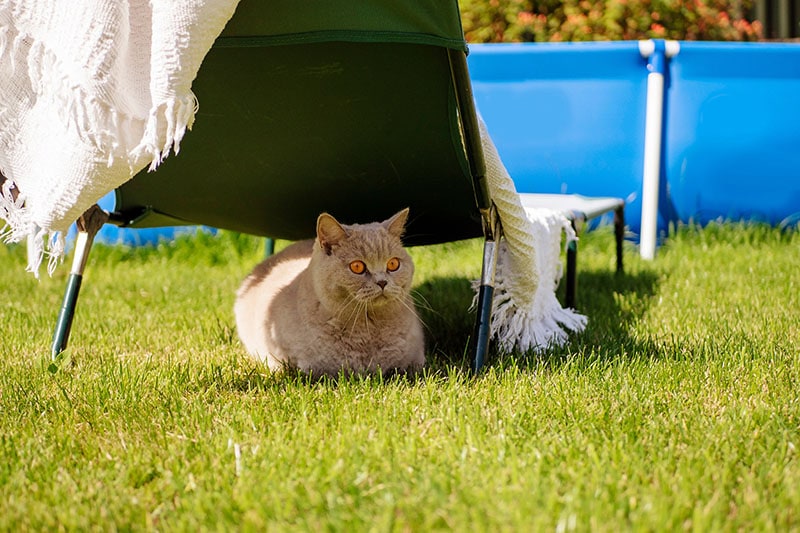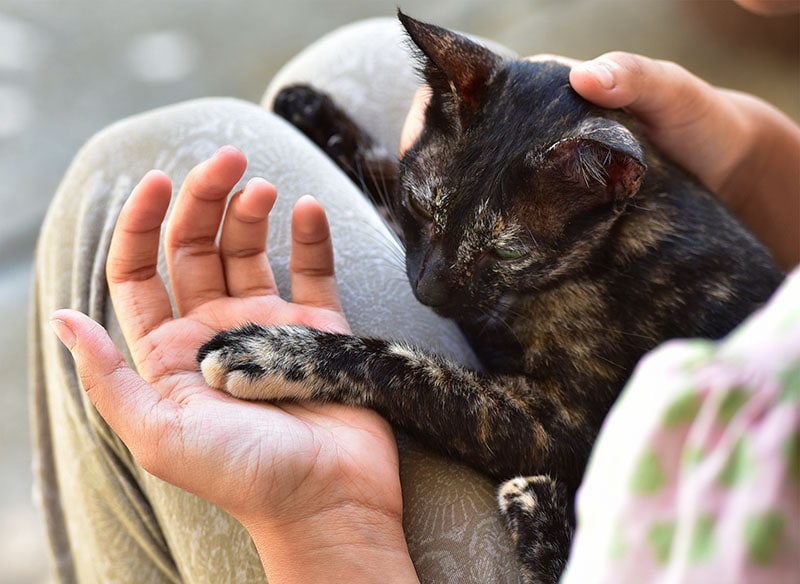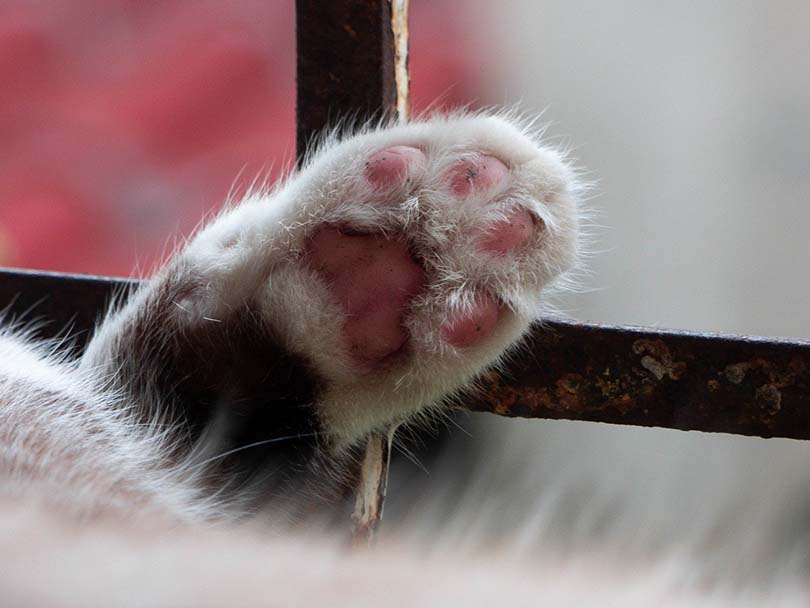VET APPROVED

The information is current and up-to-date in accordance with the latest veterinarian research.
Learn more »In the heat of the summer sun, asphalt can quickly reach around 149 Fahrenheit (65 degrees Celsius)1. In fact, in the absence of any wind and in direct sunlight, when the air temperature is 86ºF or 30ºC, asphalt can reach 135ºF or 57ºC—hot enough to fry an egg2.
While frying an egg on the asphalt may be cool, you don’t want the ground frying your cat’s paws! A quick test that you can do is to press the back of your hand against the pavement and if you can’t hold it there for a full seven seconds it’s too hot for a pet’s paws.
This means that if your cat frequently travels outside in hot weather, they may need extra protection from the asphalt. If their paws are exposed to hot surfaces long enough, it can cause serious injuries.3
In this article, we look at a few different ways that you can prevent burns on your cat’s paws when the roads and driveways start heating up.

The 5 Ways for Protecting Cat’s Paws From Hot Pavement
1. Avoid the Asphalt as Much as Possible

The easiest way to avoid burns is to avoid the asphalt as much as possible. There isn’t much you can do to keep the asphalt cool in sunny, hot weather, and most other methods are hit or miss. If you’re looking to completely avoid burns, blisters, and discomfort, the best thing to do is simply avoid the concrete.
Most cats aren’t going to purposefully walk on burning hot concrete unless they absolutely have to. If your cat has to cross your driveway or a hot, asphalt path after jumping outside, they may burn their paws in the process. You generally don’t have to worry about them nonchalantly standing on an out-of-the-way hot driveway, though.
Therefore, your best bet is to avoid situations where your cat has to cross hot pavement. For instance, if your cat has to walk down a hot path after they’ve been let out the front door, let them out into the grassy backyard instead.
Don’t put outside food or water in an area that requires crossing hot pavement, don’t call your cat to come to you if they need to walk on it, and provide your cat with hiding places away from it.
2. Utilize Shade

If you can, add shade to any pavement that your feline comes in regular contact with. It is often impossible to keep an area completely shaded as the sun changes position across the sky. However, if it is shaded during the afternoon, the pavement likely won’t heat up significantly. Try umbrellas in small areas, though whole awnings may be needed for some areas.
This method is most useful if there is a specific area where your feline usually walks on concrete. If they need to cross a road, though, you probably won’t be able to shade that. However, if you have a pool area that often gets hot, setting up an awning to keep the pavement shaded can provide your cat with the cool walkway they need. Plus, we’re sure your cat will enjoy the shade during the heat of summer.
3. Use Paw Wax

For dogs, you can often utilize paw wax to protect their paws during walks. Theoretically, you can also do this with cats. Paw wax prevents your cat’s paws from coming into direct contact with the hot pavement. It adds a barrier, in other words. The moisture from the waxes will also keep your cat’s paws from drying out.
Cats often don’t like the feel of wax on their paws at first, but they do get used to them with time. Many felines will walk funny at first! Luckily, paw wax is completely non-toxic and it doesn’t matter if your cat licks off a small amount.
With all that said, paw wax is often harder to use on a cat than on a dog. They aren’t staying outside for a set amount of time, usually. You probably aren’t walking around outside with your cat either, making it difficult to know when it needs to get re-applied.
Cats also use their paws for climbing, not just walking. Climbing can be obviously difficult if your cat’s claws are covered in wax!
4. Keep Your Cat Indoors

Sometimes, the only way to keep your cat from hot pavement is to keep them indoors. While your cat may detest this for a few days, it is best for their overall safety.
In general, keeping your cat indoors prevents injuries. The outdoors is full of dangers, ranging from predators to road traffic accidents, to hot pavement. If your cat is allowed outside, they are going to come into contact with these dangers. If you keep them indoors, they won’t. It’s that simple.
If your cat burns their paws, they will need to stay indoors while they heal. Often, this will take at least a few weeks. Your cat won’t be able to get around well and will likely need to wear bandages on their feet. Going outside during this healing period simply isn’t appropriate.
You may decide to simply keep them inside after they’ve healed. If they’ve already been kept inside for a few weeks, this can be a good opportunity to consider keeping them indoors permanently.
5. Check Your Cat’s Paws Frequently

If your cat spends time outside, you should be giving them regular checks to ensure they don’t have any injuries. During the summer and winter months alike, this quick check should include their paws. During the summer, hot pavement can cause burns. In the winter, salt from the roads can dry out their paws and cause cracking, which can cause just as many problems as burns.
If you do notice injuries, you should take your cat to the vet right away. Minor burns are difficult to notice, so most pet owners won’t pay them a second glance. However, if you can see your cat licking their paws, limping, or you notice burns on your cat’s paws, they require veterinary attention. Since the burns are on the bottom of the paws, they can quickly become infected. Your cat will likely be in serious pain as well, even if they don’t show it.
Cats are notorious for hiding their discomfort. They will likely act like everything is completely fine, even if they’re having serious difficulty walking.

Final Thoughts
Keeping your cat protected from hot pavement can be extremely challenging. The only sure way to prevent burns is to keep your cat away from pavement altogether, which typically involves keeping them indoors.
Paw wax and shade can be helpful in preventing burns on outdoor cats, but these solutions often aren’t simple. You can’t follow your cat around outside and continuously apply paw wax. Plus, there is the challenge of keeping your cat still enough to actually apply the wax.
Cat boots are not appropriate for outdoor wear. They may protect your cat’s paws from the heat, but then your cat won’t be able to climb and protect themselves from the predators.
If your cat’s paws do get burned, veterinary attention is always required. Paw wounds are difficult to heal and can easily reopen without proper bandaging, leading to infection. The sooner you seek treatment, the faster they’ll heal, so be sure to consult with a vet, especially if burns and blisters are present.
Featured Image Credit: Aldair-Pho, Pixabay











